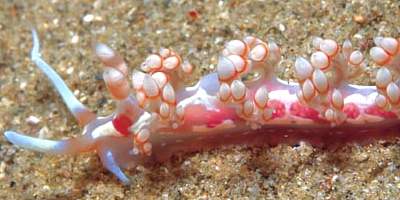
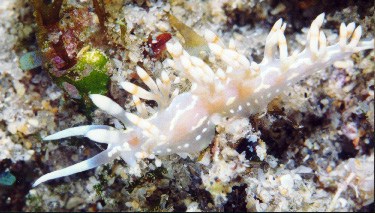
Flabellina engeli
Marcus & Marcus, 1968
Order: NUDIBRANCHIA
Suborder: AEOLIDINA
Family: Flabellinidae
DISTRIBUTION
Caribbean - Curacao, Bolivia, Barbados, Florida, Puerto Rico.
PHOTO
Upper: Tobago, West Indies, Depth: 1.5m., Size: 1.5 cm. Photo: Solomon Baksh
Lower: South Florida coast, USA. 6 to 12 feet of water. Photo: Linda Ianniello.
In the original description of F. engeli the colour of the living animal was only scantily described. "transparent pinkish white body with scarce brown pigment granules. .. cerata light brown, each with darker brown ring. Opaque white spot between tentacles, one on each side behind them, streaks and spots between the footstalks of the cerata, and a dorsomedial stripe along tail.". Triangular opaque patches of unknown colour are shown on the side of the body between the ceratal clusters in Marcus' drawings of the preserved animals which correspond to the orange patches in the attached photos. Also in Marcus' drawings a submarginal row of spots can be seen along the foot. From Linda Ianniello's photos these can be seen to be white. From the original description, the subsequent description by Edmunds & Just (1983), and Linda Ianiello's photos the colour can be summarised as follows.
Body translucent with opaque white markings. There are usually white bands on each side running between the ceratal clusters, and a white band along the dorsal midline of the posterior foot. There can also be a white patch on each side of the head and anteriorly between the oral tentacles. The oral tentacles are white except at the base where they are translucent clear. In some cases the white bands are broken into a more irregular pattern of white streaks. There are usually orange or yellow triangular patches on each side of the body between the ceratal clusters. There is a submarginal row of opaque white spots along the foot. The cerata are translucent with a brown or orange band about a third the way down from the tip. The rhinophores are lamellate and the animal grows to approximately 20mm.
References:
• Edmunds, M. & Just, H. (1983) Eolid nudibranchiate Mollusca from Barbados. Journal of Molluscan Studies, 49(3): 185-203.
• Marcus, Ev. & Marcus, Er. (1968) Flabellina engeli, a new nudibranch from Curacao. Beaufortia, Zoological Museum Univ. Amsterdam, 15: 139-142
Rudman, W.B., 2001 (October 8) Flabellina engeli Marcus & Marcus, 1968. [In] Sea Slug Forum. Australian Museum, Sydney. Available from http://www.seaslugforum.net/find/flabenge
Related messages
New records from Brazil [3]
August 23, 2007
From: Vinicius Padula
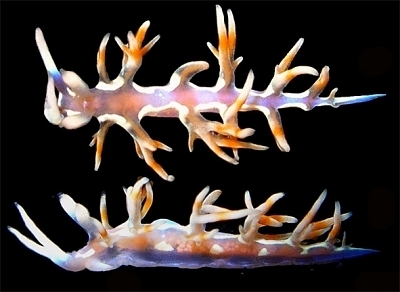
Dear Bill,
In our new paper [see #20244 ] there are new records of some species for Brazilian waters including Flabellina engeli.
- Padula, V. and Santos, F. N. (2006) Three new records of Nudibranchia (Mollusca, Gastropoda) - Additions on the Brazilian Biodiversity. Biociencias, Porto Alegre, 14: 214-220.
Best wishes,
Vinicius
viniciuspadula@yahoo.com
Padula, V., 2007 (Aug 23) New records from Brazil [3]. [Message in] Sea Slug Forum. Australian Museum, Sydney. Available from http://www.seaslugforum.net/find/20557Thanks Vinicius,
Bill Rudman
Re: Flabellina engeli from Brazil
January 11, 2007
From: Vinicius Padula
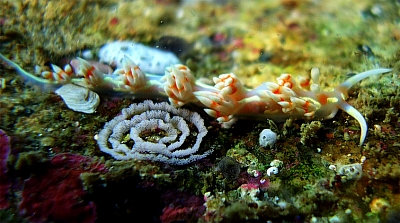
Concerning message #19138:
Dear Bill,
Was so nice to meet you last September at the fantastic 2nd Int. Workshop on Opisthobranchia in Bonn, Germany.
You are right, Flabellina engeli is a new record for the Brazilian waters. Here is a photo of mine of another Brazilain record. I believe that this year one paper will be published with some new records of aeolids in Brazil, including F. engeli.
It's interesting that this species repeats what we know about the distribution of some other species described by Marcus and Marcus for the Western Atlantic: the occurrence at São Paulo and the Caribbean region. Between these two localities there is a long distance that we have few data, but probably most of these species have a continuous distribution between the Caribbean region and the southeast coast of Brazil (see the map).
In Brazil, Flabellina engeli can be found in Rio de Janeiro, São Paulo and Santa Catarina region.
Best wishes,
Vinicius Padula
viniciuspadula@yahoo.com
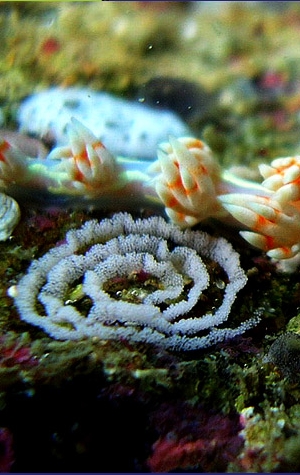
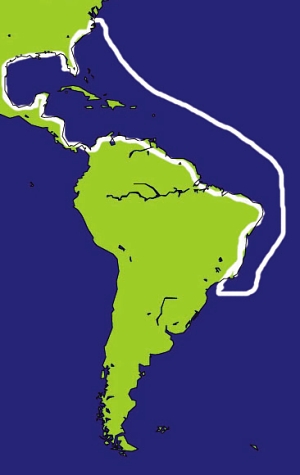
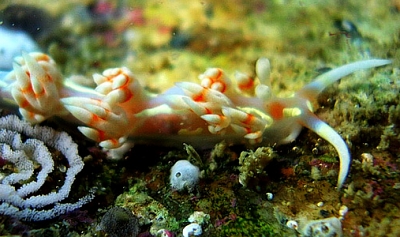
Dear Vinicius,
September in Bonn seems so long ago! It was wonderful meeting up with old friends and new friends who I have corresponded with, but have never actually sat down with, to share a pizza and beer and endless talk of sea slugs! I am sure you probably showed me photos of this species from your collecting activities in Brazil.
From the literature, and other photos on the Forum, the markings in this species are said to be opaque white, but your photo shows very clearly that they can range from opaque white to yellow. It is also valuable to get a photo of the egg ribbon. I look forward to your paper.
Best wishes,
Bill Rudman
Flabellina engeli from Brazil
January 10, 2007
From: Armando de Luca Jr
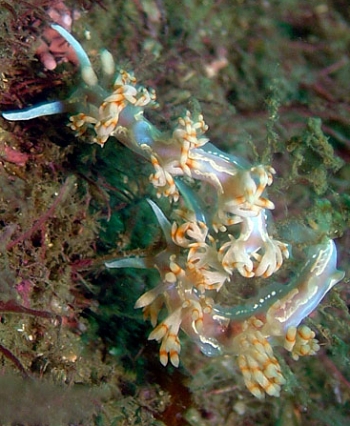
Dear Bill,
This photo of Flabellina engeli was taken in Laje de Santos Marine State Park (24º 19' 18" S ; 46º 10' 57" W), Sao Paulo, Brasil.
Locality: Laje de Santos Marine State Park, 24 m, Sao Paulo, Brazil, Atlantic Ocean, 24 May 2006, Rocky bottom. Length: 30mm. Photographer: Armando de Luca Jr.
Best wishes.
Armando de Luca Jr
mergulho@nautilusdive.com.br
de Luca, A., 2007 (Jan 10) Flabellina engeli from Brazil. [Message in] Sea Slug Forum. Australian Museum, Sydney. Available from http://www.seaslugforum.net/find/19138Dear Armando,
Thanks for this record. I think this is the first record of the species from Brazil. From a quick look at the literature I don't think it is has been recorded outside of the Caribbean before.
Best wishes,
Bill Rudman
Re: Flabellina engeli from Tobago
January 27, 2006
From: Patrick Weir
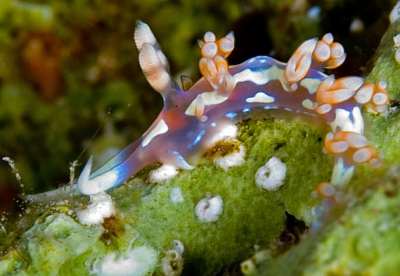
Concerning message #10753:
Locality: Grand Cayman, Cayman Islands. Caribbean Sea. Depth: 40 ft. Length: 10 mm. 25 January 2006. On top of coral head, little sand. Photographer: Patrick Weir
Patrick Weir
digitaldiver@gmail.com
Weir, P.J., 2006 (Jan 27) Re: Flabellina engeli from Tobago. [Message in] Sea Slug Forum. Australian Museum, Sydney. Available from http://www.seaslugforum.net/find/15670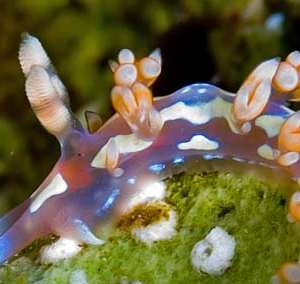
Dear Patrick,
Your photo shows the swollen, lamellate rhinophores very well.
Best wishes,
Bill Rudman
Flabellina engeli from Tobago
August 16, 2003
From: Solomon Baksh
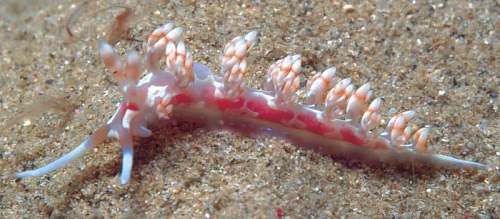
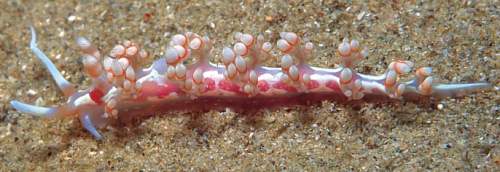
Dear Bill,
Concerning your comments on my earlier message. Sorry for the mix up in photos, this is the one. This image is the one that Eric Riesch from www.fishid.com said looks close to the Blue Streak Nudibranch. This is his reply:
"Thanks for the email. The photo of the 'Blue-Streak Nudibranch' in Humann & Deloach's (2002) Reef Creature Identification book is mine. Unfortunately this is an undescribed species. At this time there are no taxonomic biologists working on the order of nudibranchia in the Western Atlantic, therefore we cannot establish was this species is. I will hold onto your photo in case Paul Humann gets any word of a new marine biologist that is willing to work on these species IDs. Your photo seems to be a different species, but quite closely related to the one I photographed in Dominica. My specimen was also found in 10 feet of water in a rocky shoreline/ grassbed habitat. Thanks for your inquiry, sorry we could not be of more help - Eric Riesch, New World Publications"
Here are some details about my animal:
Location: Tobago, West Indies
Size: 1.5 cm
Depth: 1.5 m
There were several of these nudibranch crawling on the sand. The only noticable difference between this species and the 'blue-streak nudibranch' is the lack of the blue and black colour at the base. Hope you can help identify it.
Many thanks,
Solomon Baksh
chromis@tstt.net.tt
Baksh, S., 2003 (Aug 16) Flabellina engeli from Tobago. [Message in] Sea Slug Forum. Australian Museum, Sydney. Available from http://www.seaslugforum.net/find/10753
Dear Solomon,
This is Flabellina engeli. There are very few records of this species as well, but from those we can say that this species has a number of characteristic external features. These include the swollen lamellate rhinophores, the orange subterminal band on the cerata, and the opaque white bands between the ceratal groups on each side. Some animals are described as having orange or reddish patches on each side but from your photos, this colouration seems to be from the colour of the viscera showing through the transparent body wall. I would suggest this aspect of its colour pattern is dependent on the age of the animal, what it has recently been eating and the stage of development of its gonads.
Concerning the 'blue streak nudibranch' - the major difference I can make out in the photo in Humann & Deloach (2002) is that it has a single median white streak on the head, while F. engeli has a streak on each side of the head. I can't see the blue and black colouration.
Best wishes,
Bill Rudman
South Florida aeolid is Flabellina engeli
October 10, 2001
From: Linda Ianniello
Bill,
Sandra Millen has identified this aeolid as Flabellina engeli. Here is her note:
================
Linda,
The photo's you sent of the nudibranch look like Flabellina engeli. This animal is usually about 2 cm long. It has white or yellow lines on the dorsum and foot, I haven't seen the line broken into spots before. The swollen perfoliate rhinophores, tentacular projections on the front of the foot, clustered cerata and subterminal orange bands all fit this species. This animal does not eat green algae. It eats hydroids, but must be finding a tasty hydroid growing in or among the algae.
Keep up the good photography.
Sandra Millen,
Department of Zoology,
University of British Columbia,
Vancouver, B.C., Canada, V6T 1Z4
=================
Linda
lindai@us.ibm.com
Ianniello, L., 2001 (Oct 10) South Florida aeolid is Flabellina engeli. [Message in] Sea Slug Forum. Australian Museum, Sydney. Available from http://www.seaslugforum.net/find/5431Dear Linda & Sandra,
Thanks for solving that problem. Unfortunately when an original description is so lacking in detail it needs someone with knowledge of the living animals to make sense of the description and fill in the gaps. One interesting coincidence is that the original specimens of this species were collected on Halimeda, just as in Linda's photo.
Best wishes,
Bill Rudman
Aeolid from South Florida
October 5, 2001
From: Linda Ianniello

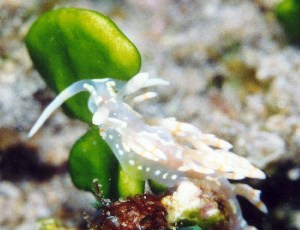
Hello everyone.
Anne DuPont suggested that I send you photos I have of a nudibranch a friend of ours found off the local south Florida coast. We are finding them in about 6 to 12 feet of water. They are very small; they don't even fill a Nikonos 2:1 framer. The white markings on the body are irregular and broken up, down the sides and center. There is a line of white spots down the side of the foot. These markings are opaque white,
on a translucent body. The Rhinophores are ringed, and solid white for the top half, translucent at the bottom. The gills are solid white, with pale orange bands about 1/3 from the top. And they are in clumps/rows down the body - not solid. In the water the tips of the rhinophores and gills appear iridescent blue, but that does not show up in the photos.
The bright green algae(?) in the lower photo appears to be what they eat. They are found on or around it. We would appreciate any help you can give us regarding their identification.
Thanks and regards,
Linda Ianniello
Boca Raton, FL
lindai@us.ibm.com
Ianniello, L, 2001 (Oct 5) Aeolid from South Florida . [Message in] Sea Slug Forum. Australian Museum, Sydney. Available from http://www.seaslugforum.net/find/5395Dear Linda,
I suspect this is a species of Flabellina but I don't recognise it from any published description. Perhaps Sandra Millen will be able to help us out. The green object you suggest may be its food looks like the calcareous green alga Halimeda. If it is an alga then it won't be this animal's food. Its large oral tentacles and is pair of swollen, probably lamellate rhinophores, show that it an aeolid rather than a herbivorous sacoglossan. Its most likely source of food would be small hydroid colonies.
Sorry I can't identify this beast for you. If it has a name, hopefully someone will come to our aid.
Best wishes,
Bill Rudman
